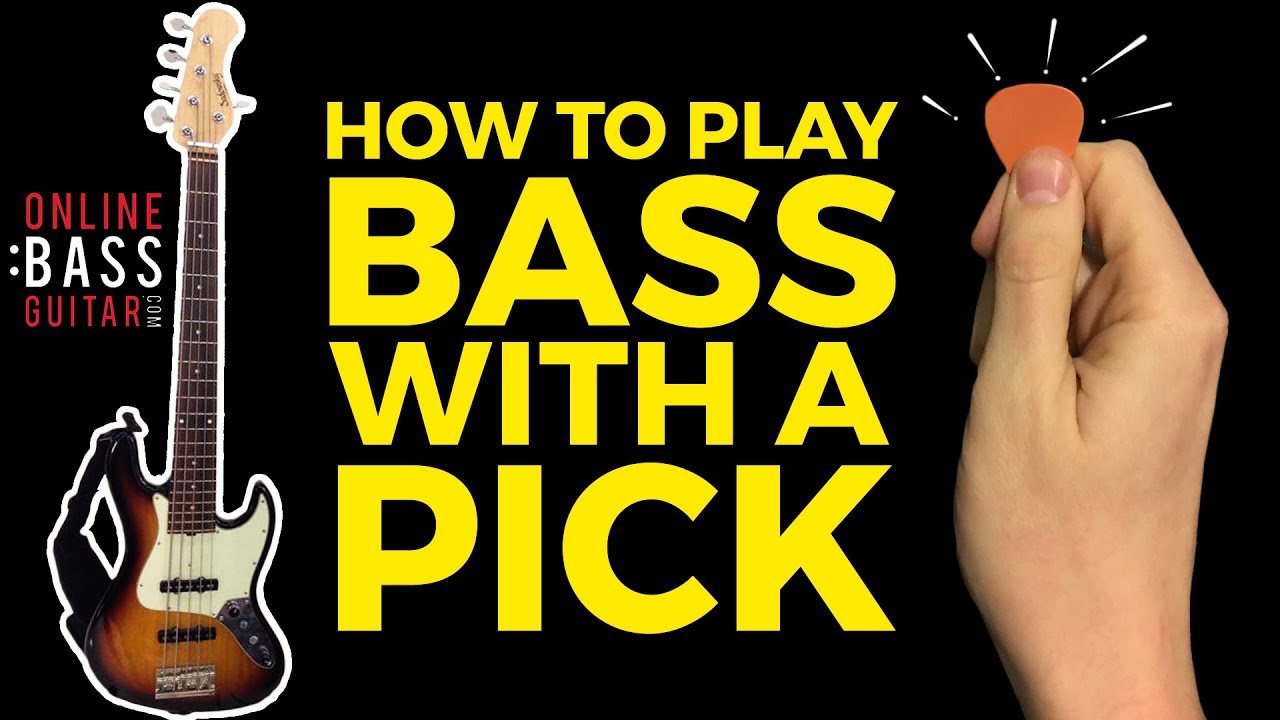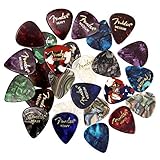Playing the bass is an art form all its own, and learning to do it properly involves mastering the use of a pick.
Knowing how to correctly hold a pick will not only help you create a better sound but also make playing the bass more enjoyable.
In this article, we’ll explore how to hold a pick; what grip works best, and offer tips and tricks for getting it right. Ready? Let’s get started!
How To Hold A Guitar Pick Correctly (For Strumming, Speed & The Like)
When it comes to playing the guitar, having a firm grasp on your pick is essential to getting the best sound quality and speed. Whether you’re strumming chords or shredding solos, holding your pick correctly will make all the difference.
Knowing how to hold a guitar pick can be confusing at first, but with the right technique and practice you’ll be ready to rock in no time!
How To Hold Your Guitar Pick – Thumb and Index Finger Basics
The proper way to hold a guitar pick is by placing it between your thumb and index finger. Make sure that your thumb is against one flat edge of the pick while your index finger is pressed slightly against its other side.
This grip should feel comfortable and secure while leaving room for movement of both fingers if necessary. When you strum or play notes, the motion should come from your wrist rather than from the fingers gripping the pick itself.
This will help ensure that you are using just enough pressure on the strings without overworking them – something which could lead to unnecessary wear and tear on your instrument’s strings.
Learning To Hold A Guitar Pick Is The Secret To Playing Guitar Fast
In order to play fast, you must have control over your instrument and this includes being able to confidently hold a guitar pick between your thumb and index finger.
You’ll also need to move quickly between chords without missing any notes or making mistakes; in order for this kind of dexterity, it’s key that you use a consistent grip when holding a guitar pick instead of changing up how you position it each time.
Utilizing the correct form will help increase speed as well as provide better sound quality when playing complex riffs or licks!
How To Hold Pick For Speed
If increasing speed is what you’re after then there are some key tips that can help make a big difference when holding a guitar pick.
First off make sure that only the very tip of the pick is touching the strings – any more than that may hinder progress because too much material coming into contact with them cause unwanted drag on their surface!
Also, try applying slight pressure with your fingertips so as not to lose grip on fast passages – this will eliminate the chances of dropping it during an important solo!
Lastly, be mindful of how tight or lose you’re holding onto it – tension can lead to discomfort at higher speeds so find what works best for comfort level when practicing single note runs quickly over long periods of time!
Watch this video to make things easier
If you want to learn how to hold a guitar pick and to pick properly then take a look at this video.
The video is specifically for the bass guitar but I’m well aware there may be guitarists reading this article too so just be aware that some things will translate well to guitar picks and others will relate specifically to bass guitar picks.
You’ll also have to consider your own preferences regardless of whether you play the bass or the electric guitar.
This method of how to hold a guitar pick between the finger and thumb might feel great to you but less good to others so just try this way to hold it and see if it works for you.
Keep in mind though, there are certain things that will feel uncomfortable but are still good to do.
Keeping a straight wrist or rotating from the elbow are examples of this. Because of our physiology, these are non-negotiables.
Other things like using thicker picks, using the technique on acoustic guitar or even how to hold your pick should be up to you.
But I Saw So And So Holding Their Pick Differently! Are You Sure You Know What You’re Talking About?
Yes, and if you don’t believe me, watch this video of Chris Thile (one of the best mandolin players of all time) teaching the same technique.
If it’s good enough for him, then the rest of us will be fine.
How To Master Proper Pick Position Step-By-Step
Mastering proper pick position is essential to playing the guitar correctly and achieving optimal sound and speed. Here are some easy steps you can follow to master proper pick position:
Place your thumb on top of the pick and your index finger on the bottom. Make sure the two fingers meet at a 90° angle for maximum control.
Hold the pick with a firm but relaxed grip between your two fingers so that you don’t put too much pressure on it and cause it to change shape.
Keep your wrist loose, practice moving from one chord to another so that all notes ring out cleanly and clearly as they should.
Gradually increase your speed as you become more comfortable and confident in using proper pick position.
How To Hold A Guitar Pick When Strumming
When strumming, it’s important to keep a light grip on the pick, allowing it to move freely between your index finger and thumb with each stroke of the strings.
As you become more confident in controlling the movement of the pick, reduce your grip slightly, allowing for greater dexterity when strumming complex chords or patterns.
As you practice different strum techniques, pay close attention to how much force you are putting behind each stroke – this will help you create an even tone throughout your music!
Should I Change The Way I Hold A Guitar Pick?
The answer will depend on what type of style you plan on playing; certain genres require specific techniques when it comes to picking motions (such as metal or jazz).
If this is something that interests you then yes – experiment with different grips as needed until you find one that works best for your personal playing style!
That being said – many players find they get better results by keeping their grip consistent despite genre changes – provided they use correct form (with minimal pressure) when doing so!
How Close To The Tip Do You Hold A Guitar Pick?
The distance from the tip of a guitar pick that should be held between one’s thumb and first finger will ultimately depend on how large or small their hands are – though generally speaking it should still be kept at about 0.5 inches from its tip for proper handling purposes!
For thinner picks (or those made from harder materials) aiming closer to 0.25 inches may provide better control due to increased friction against fingertips – however, this could also lead to discomfort over prolonged periods of time so keep adjustments minimal unless absolutely necessary!
How To Improve Picking
The best way to improve your picking technique is to practice regularly.
Start by mastering the basics such as holding the pick correctly between your thumb and first finger, using a light but firm grip and making sure that you only use the very tip of the pick when playing notes or chords.
Once you’ve got these fundamentals down, focus on increasing speed, accuracy and dexterity so that you can play complex riffs at rapid speeds without missing any notes or making mistakes.
What Size Pick Do I Need?
The size of guitar pick you need will depend on what style of music you are playing – larger picks are usually best for strumming chords while smaller ones are preferred for intricate lead lines.
Generally speaking, most players find that thinner picks work better overall due to their lighter weight and increased friction between them and the strings – however this is ultimately up to personal preference!
Experiment with different sizes until you find one that works best for YOUR skill level and musical style.
Gradually Increase Speed
Once you have mastered basic picking techniques such as proper form, correct pressure, etc., it’s time to start gradually increasing speed so that you don’t miss any notes or make mistakes when playing riffs or solos.
Start by focusing on each note one at a time; once those become second nature then it’s time to move up to two notes per beat (or string) before progressing further from there!
Pay close attention to how much pressure your fingers are applying onto the strings – too much may cause unnecessary wear and tear as well as sound quality issues due to an uneven tone.
How Do I Strum With A Guitar Pick?
Strumming with a guitar pick involves using an up-and-down motion with your wrist against the strings in order to produce a series of notes or chords.
It is important not to grip the pick too tightly when strumming so that the whole movement comes from your wrist instead of just your fingers; this will make sure that all of the strings ring out clearly instead of becoming muffled due to excessive pressure being applied onto them!
Additionally, be sure use only light strokes with each movement – hard strums can lead to damage over time so practice slowly until you get used to this technique before increasing speed later on!
What Do I Do With My Strumming Arm?
When strumming with a guitar pick, it is important to keep your strumming arm in a relaxed and comfortable position to facilitate the up-and-down movement of your wrist.
It is also important to keep your elbow close to the body while doing this so that you can maintain proper control over the strings.
If you find yourself having difficulty with this, try keeping an eye on your reflection in a mirror – this will give you an idea of how you look like when playing and help you make adjustments as needed.
Alternate Picking
Alternate picking is a technique used in guitar playing where each note or chord is played with a downstroke followed by an upstroke (or vice versa).
This method of picking produces a much smoother sound than strumming and allows for greater speed and accuracy when playing single notes, scales or arpeggios.
Additionally, alternate picking enables guitarists to play both lead and rhythm parts at the same time – something which cannot be done with other techniques!
How Do I Alternate Pick?
To properly execute alternate picking, start by keeping your forearm either still or slightly moving; then use only your wrist and fingers as guide points for the direction of the pick stroke – down strokes should come from underneath and upstrokes from above.
Remember: never grip the pick too tightly as this may hinder your ability to switch between down/upstrokes quickly.
Even if you never see yourself using alternate picking, it’s well worth learning simply for the level of control of how to hold a guitar pick that you’ll develop through learning it.
The best guitar and bass players will always push themselves to learn new things like this to gain a small win or technical improvement, whether that’s how to hold the pick properly, to learn the correct way to rotate the arm, to improve the picking hand, to find a new way to use a pick, or just because they are unsatisfied with their technique and feel they don’t use the pick the right way.
Practice this technique slowly at first before gradually increasing speed until all notes are being played cleanly and accurately!
Is a guitar pick good for beginners?
A guitar pick is an essential accessory for beginner players.
However, using guitar picks does not necessarily make you a better guitarist or bass player.
It’s simply a different tool to have in your arsenal.
Should you hold guitar pick at an angle?
By holding guitar picks at an angle you are able to easily transition between strings.
This is much better using movements than picking at a strict 90-degree angle.
However, the more angled the pick is then the more gnarly the tone will be.
Think of it as a spectrum.
The flatter you hold the pick, the more rounded and warm the tone will be. But the more you hold the pick at an angle then the more aggressive and angular the sound will be.
Is there a wrong way to hold a guitar pick?
Yes, there is a wrong way to hold a guitar pick. The most common mistake is gripping it too tightly between the thumb and first finger, which makes it difficult to switch between downstrokes and upstrokes quickly.
Additionally, holding the pick too close to its tip will result in muffled notes due to an uneven tone.
For best results, use a light, firm grip with only the very tip of the pick coming in contact with the strings.






Leave a Reply